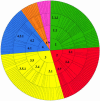The Catalytic Site Atlas: a resource of catalytic sites and residues identified in enzymes using structural data
- PMID: 14681376
- PMCID: PMC308762
- DOI: 10.1093/nar/gkh028
The Catalytic Site Atlas: a resource of catalytic sites and residues identified in enzymes using structural data
Abstract
The Catalytic Site Atlas (CSA) provides catalytic residue annotation for enzymes in the Protein Data Bank. It is available online at http://www.ebi.ac.uk/thornton-srv/databases/CSA. The database consists of two types of annotated site: an original hand-annotated set containing information extracted from the primary literature, using defined criteria to assign catalytic residues, and an additional homologous set, containing annotations inferred by PSI-BLAST and sequence alignment to one of the original set. The CSA can be queried via Swiss-Prot identifier and EC number, as well as by PDB code. CSA Version 1.0 contains 177 original hand- annotated entries and 2608 homologous entries, and covers approximately 30% of all EC numbers found in PDB. The CSA will be updated on a monthly basis to include homologous sites found in new PDBs, and new hand-annotated enzymes as and when their annotation is completed.
Figures




References
-
- Berman H.M., Battistuz,T., Bhat,T.N., Bluhm,W.F., Bourne,P.E., Burkhardt,K., Feng,Z., Gilliland,G.L., Iype,L., Jain,S. et al. (2002) The Protein Data Bank. Acta Crystallogr. D., 58, 899–907. - PubMed
-
- Bartlett G.J., Porter,C.T., Borkakoti,N. and Thornton,J.M. (2002) Analysis of catalytic residues in enzyme active sites. J. Mol. Biol., 324, 105–121. - PubMed
MeSH terms
Substances
LinkOut - more resources
Full Text Sources
Other Literature Sources
Molecular Biology Databases
Research Materials

